|
Monday, October 22, 2012
Progress Notes
A few years ago I visited Betty Hoops Eads, wife of the now deceased James Eads, son of Alf Eads, to acquire information and photos regarding the Alf Eads Ford automobile dealership and history of the Eads family. Alf was the original owner of the Ford automobile franchise in Iberia.
(You can read more about Alf and his family at this previous Progress Notes.)
During the interview Betty reminded me of a portrait she had given the museum of her great grandfather, Jeremiah W. Tallman, who was a Civil War veteran, having fought for the North (photo 01).

01 Jeremiah Tallman Framed Portrait
What I hadn’t known until Betty told me then was that behind the portrait of Jeremiah inside the frame was a portrait of his wife, Hannah Maria Brown Tallman. So, later we extracted the portrait of Hannah and placed it in its own frame (photo 02).
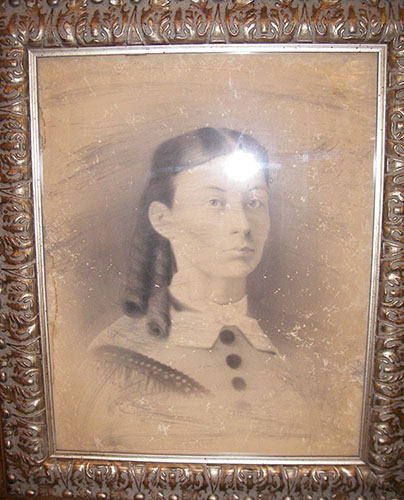
02 Hannah Maria Brown Tallman
The photo of Hannah is not great because of flash reflection from my camera so here is a better one outside the frame (photo 03).
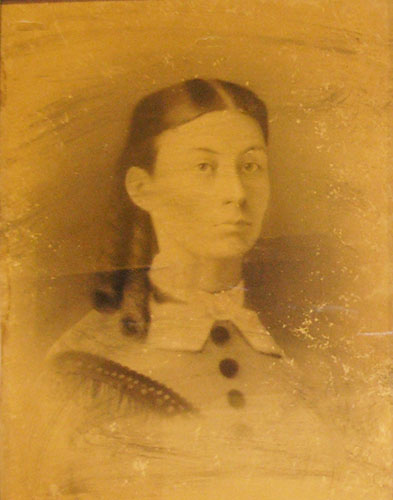
03 Hannah Maria Brown Tallman
Betty said she was born Betty Sue Hoops. Jeremiah Tallman’s daughter was Vivian who married J. L. Hoops. Their son, George Hoops, was the father of Betty. J. L. Hoops had a hotel, general store, funeral home and a mill at Crocker. Betty is a great granddaughter of Jeremiah Tallman. Here is a photo of Betty and her daughter, Karen Eads Atwill (photo 04).
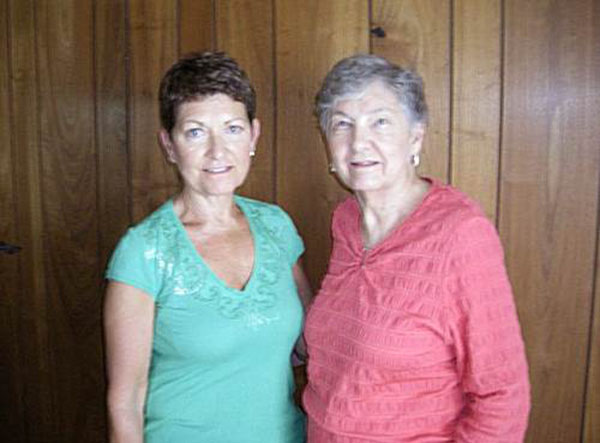
04 Karen Eads Atwill and Betty Hoops Eads
Betty has written a short narrative about her great grandfather, Jeremiah W. Tallman:
Honorable Jeremiah W. Tallman
1841-1916
Written by Betty Hoops Eads, great granddaughter of Jeremiah W. Tallman
Jeremiah Tallman was born in Lycoming County, Pennsylvania in 1841. He was educated in the common schools of that county and at the Dickerson Seminary, Williamsport, Pennsylvania. In 1860, he came with his family to Miller County.
When war broke out, Jeremiah was elected Second Lieutenant of a company of Pennsylvanians for defense of their homes. Later, after moving to Missouri, on July 12, 1861 he enlisted for three years in Company F, First Regiment, Missouri Infantry. Later, he was commissioned Captain of Company G. 50th Regiment, Missouri Infantry and served until the war was over.
In the spring of 1866, there being much lawlessness and many murders in Miller County, Mr. Tallman was commissioned by Governor Fletcher as 1st Lieutenant of a company of forty picked men to try and cope with law breakers. He was also appointed deputy sheriff and within a year the county was purged of the lawless classes.
While in the line of duty Mr. Tallman had captured a prisoner and two accomplices of the outlaw had come to his rescue. One of them shot Jeremiah through the chin and the other shot him through the right wrist, thereby disabling him for life.
After serving as deputy sheriff three years, he was twice elected Judge of the Probate Court and three times elected County Treasurer of Miller County.
Judge Tallman was married in 1869 to Hanna Maria Brown. Their daughter, Vivian, married James L. Hoops, a merchant from Crocker, Missouri.
As I was reviewing the history of the Tallman family I discovered there were two men named Jeremiah Tallman in the Iberia area. Jeremiah W. Tallman was the son of William Tallman and Jeremiah Tallman was the son of William’s brother, Charles Tallman. Peggy Hake has written about the Tallman family which I will present here:
When military groups were formed in the Union army, the younger Pennsylvanians enlisted and fought in many battles. Some of the soldiers were: John Brown Tallman; Jeremiah W. Tallman, son of William Tallman; Jeremiah Tallman, son of Charles Tallman; William Brown Tallman and John D. Brown.
After the war Jeremiah Tallman became active in Miller County politics serving as Sheriff, Judge of the Probate Court; and three times elected County Treasurer.
Charles Tallman served as a justice of the peace for a number of years; served a term as associate judge of the County Court; and was appointed by the governor to an important office in January, 1869, but he died one month later from lung congestion.
The families of Charles and William Tallman, John Bennage, Benjamin Groff, all of Lycoming County, Pennsylvania and William Irwin of Mifflinburg, Union County, Pennsylvania, came to Missouri just shortly before the Civil War. Colonel Moore had written these folks telling them that the land was cheap; the country side desirable, and a man’s living was easy in Missouri. Due to his urging, they all moved here about the same time in the mid 19th century.
William Tallman was educated in the public schools at Williamsburg and his first job was working for his father in the boat and shoe business. He later worked in Philadelphia at the same trade. He learned surveying and assisted in laying out the new town of Lock Haven, Pennsylvania before finally getting the ‘westward fever.’
Charles Tallman spent most of his life on his father’s farm across the west branch of the Susquehanna River near Williamsport. (This is gorgeous country! I took a trip through our eastern seaboard states in 1976 and I followed the Susquehanna River across Pennsylvania through Williamsport, Harrisburg, and southward into Maryland).
Charles Tallman married Isabella Brown and they settled in White Deer Valley near the old Brown homestead. He and Isabella reared their children on this farm and in their later years of life they sold out and came to Miller County, arriving in April of 1860. Charles died in 1869, only one month after being appointed to an important job by his personal friend, Joseph Washington McClurg, Missouri’s Governor from Camden County, elected in November, 1868.
In Peggy’s narrative above I am assuming that the Jeremiah Tallman without the middle initial “W” is the son of Charles Tallman and the Jeremiah which includes the middle initial “W” is the son of William Tallman.
The Tallman family had a large collection of letters written during the time of the Civil War which were sent to the archives of the University of Missouri at Rolla. More about that is copied here from that website:
Tallman Family
Tallman-Brown families, letters, 1861-1868
Two folders, photocopies and typescripts
This is correspondence of related families of Miller County, Missouri. The principal correspondents are John, Martha, and Matthew Tallman, who wrote to their brother, Jeremiah, while he served in the 1st Missouri Light Artillery, and John D. Brown, of the same regiment, who wrote to his sister, Hannah M. Brown. Topics include military activity in Miller County and southern Missouri, farm life, and family matters.
The Tallman-Brown correspondence is a useful collection for research on Miller County and the Richwoods community. In addition to news directly related to the principal families, the letters contain details on neighbors in the Richwoods, including the Bennage, Carroll, Long, and Moore families. The collected letters are the result of the marriage of Jeremiah W. Tallman and Hannah M. Brown in 1869. The papers passed into the possession of a collector of postal history, from whom they were acquired by the donor.
Matthew Brown brought his family from Lycoming County, Pennsylvania, to Miller County, Missouri, in 1859. The Browns were followed to Missouri shortly thereafter by their neighbors, Charles and William Tallman, and their families. The Browns and Tallmans were among a number of families from east central Pennsylvania who removed to the Richwoods area south of Iberia in Miller County, Missouri, just before the Civil War.
The Civil War disrupted the Richwoods neighborhood and a number of the former Pennsylvanians joined the Union army. Among them were two of William Tallman’s sons, John B. and Jeremiah W., and Charles Tallman’s son, William B. Tallman. Matthew Brown’s son, John D., also enlisted. John D. Brown and Jeremiah W. “Jerry” Tallman both enlisted in the 1st Missouri Light Artillery and served in Missouri and Arkansas. John D. Brown received a medical discharge from the army and returned to Miller County in 1864, while Jerry Tallman secured a commission as a first lieutenant in the 48th Missouri Infantry and served to the end of the war.
The collection consists of forty-four letters beginning on 10 November 1861 and continuing through 24 December 1868. The separation of the families caused by the war accounts for most of the correspondence in the group. Of the total, thirty-two of the letters were written to, or by, family members in military service. Seventeen were addressed to Jerry W. Tallman, of which sixteen were written by his brothers, John B., Matthew, and Robert T., his sister, Martha, and his father, William Tallman. The letters from home contain a considerable amount of news about Miller County and the Richwoods community, including the health of family and friends, the activities of secessionist and Confederate guerrillas, the countering measures undertaken by Union forces such as the organization of the militia, and news regarding activities on the family farm. John B. Tallman, serving in a Missouri cavalry regiment, wrote his brother and comrade in arms from army camps at Springfield and Cassville, Missouri, and Austin and Brownsville, Arkansas. He re-counted camp rumors and incidents of army life, and confessed that he was very impressed by the ladies in the vicinity of Brownsville, even though they were all “Rebs.”
The other letters in the collection are addressed to Hannah M. Brown, the daughter of Matthew and Nancy (Tate) Brown. Many of the letters are from her brother, John D. Brown, from camps at Georgetown, Otterville, Sedalia, McCulloch’s Farm, Mount Vernon, Cassville, Bloomington, and Lake Spring, Missouri. His letters report on army movements and operations, including the activities of his artillery battery during the Battle of Newtonia, Missouri, in 1862. Hannah also received letters from relatives in White Deer Valley and Pleasant Valley, Pennsylvania, from her sister, Jane, who was attending school in Jefferson City, and from relatives and friends who had left the Richwoods neighborhood. Among the latter was Jerry W. Tallman, who apparently began courting Hannah Brown sometime after the Civil War ended. The postwar items include three letters written by Tallman from Tuscumbia, the seat of Miller County. Along with endearments to his future wife are descriptions of people and events in Tuscumbia, and of Tallman's appointment as county treasurer.
Jerry Tallman and Hannah Brown married in 1869. The 1870 census lists them and their six month old son as residents of Equality Township in Miller County. Tallman was active politically and served terms as Miller County treasurer, sheriff, and probate judge. The Tallmans moved to Crocker in Pulaski County, Missouri, in the 1890s, where Jeremiah engaged in the furniture business. By 1910, he was back in Miller County. The Missouri veteran's census of that year lists him as widower.
The collection has been filed in chronological order. Two letters on which the year is not noted have been placed at the end of the file. A register of the correspondence is available.
We have a photo of the Iberia GAR (Grand Army of the Republic) which includes a Jerry Tallman (photo 05).
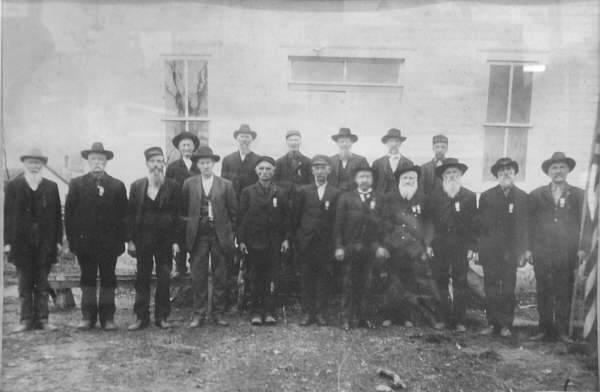
05 Iberia GAR
Here is the caption for the photo:
Front Row L-R: Jim Berry, James Cross, Jerry Tallman, Epaminandos Deampird (E.D.) Hays, Steven Deardeuff, Simon Deardeuff, John Ferguson, Thomas Marchant, Absalom Bear, John Carroll
Back Row: Benjamin Fike, John E. Dickerson, George Teaverbaugh, Joe Crismon, William C. Thompson, John Brown.
I am assuming that the Jerry Tallman in the GAR photo is the son of William Tallman because the beard he has in that photo is very similar to the beard of the Jerry Tallman in the portrait displayed above.
You can read more about the Tallman family at these locations on our Miller County Museum webpage:
http://www.millercountymuseum.org/archives/100726.html
http://www.millercountymuseum.org/bios/bio_a.html
http://www.millercountymuseum.org/archives/090105.html
We have a portrait on the wall of the kitchen located in the old time “dogtrot” house of the museum which is of a man named Richard Watson Anderson. This portrait also was donated to us by Betty Hoops Eads (photo 06):

06 Richard Watson Anderson
Richard himself was not related to the Tallman family but he had married Harriet Hoops who was an aunt of James Leonard Hoops, husband of Jeremiah Tallman’s daughter, Vivian Imogene Tallman. James and Vivian’s son, George Hoops, was Betty’s father.
Richard was born 19 Oct 1839 in Maries Co., son of Thomas A. and Myra (Wiseman) Anderson; and died 10 Mar 1908. He’s buried in the Crocker Cemetery. He married Harriet Hoops about 1860. She was born 23 Dec 1843 and died 4 Sep 1910—also buried in Crocker Cemetery. The Hoops family was in the funeral home business in Crocker.
Betty’s father, George Hoops, passed away in 1959. His obituary is copied here:
George T. Hoops 1898-1959
George T. Hoops, prominent Crocker, Missouri merchant, and a brother to Paul Hoops of Waynesville, passed away at his home in Crocker last Sunday, following a heart attack. Mr. Hoops, who had been in ill health for some time, had planned to retire from business after the first of the year.
Mr. Hoops was one of the leading business men in Pulaski County and had been in the General Mercantile business all his life, having been manager of the J.L. Hoops and Sons store, which was founded by his father.
Mr. Hoops was an ardent hunter and fisherman, and only last all spent some time in Wyoming hunting deer. His untimely death will be felt by the hundreds of friends and neighbors.
George T. Hoops, son of J.L. and Vivian Tallman Hoops, was born n Crocker March 20, 1898. He died December 27, 1959 at his home in Crocker where he spent his entire life.
George was owner of J.L. Hoops and Sons Store which was established by his father, J.L. Hoops in 1896. On November 12, 1922 he was married to Effie Krause of Crocker. He is survived by his wife, Mrs Effie Hoops, two daughters, Mrs. Jimmie Eads of Iberia, and Mrs. Gene Densmore of Somerset, Kentucky, and a son Randy, of the home; two granddaughters, Judy and Karen Eads of Iberia, and a grandson, David Densmore of Somerset, Kentucky, a sister, Mrs. Wilson Hall of Jefferson City, and a brother, Paul, of Waynesville, and his stepmother, Mrs. J.L. Hoops of Crocker. He is also survived by two nieces and a nephew.
In his youth he was united with the Crocker Presbyterian church, and was a member of this church at the time of his death. Funeral services were held at 2:30 p.m., Tuesday, December 29 at the Crocker Presbyterian church with Reverend Benjamin A. Meeks officiating. Burial was in the Crocker Memorial cemetery under direction of Hedges Funeral Home of Crocker.
I remember Reverend Meeks. He was the minister at the Tuscumbia Presbyterian church when I was a boy still living at home in Tuscumbia. He preached at Crocker also. When he first came to the area he lived in Tuscumbia but later moved to Crocker. Reverend Meeks was a very kind person who also was inspiring from the pulpit. When he lived in Tuscumbia he loved to spend his free time in the evenings visiting with people at the service station and store located at the Highway 17/52 junction in Tuscumbia.
I found a short biography of him at this website:
“Benjamin A Meeks graduated from Columbia Theological Seminary in 1926, and then served as a Minister in Presbyterian Churches across the Southeast for 35 years. Standing six feet four inches and weighing 250 pounds, the Reverend Meeks made an impression on all he met. Matching his size was an unbending devotion to God's Word and a life based on those principles. Some of the churches he served were in: Moss Point, Mississippi, Knoxville, Tennessee, Concord, Tennessee and Chattanooga, Tennessee, West Jefferson, North Carolina, Crocker, Missouri and Pine Bluff, Arkansas.”
Dwight Weaver of Lake Ozark, Missouri is very well known as the preeminent historian of the area regarding anything to do with the Lake of the Ozarks (photo 07).
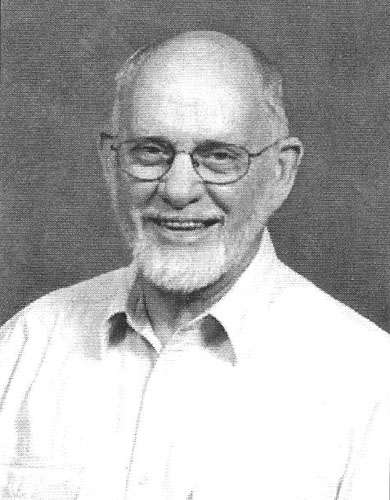
07 Dwight Weaver
I have quoted him on numerous occasions in previous Progress Notes when discussing the Lake area. He has written four books about the history of the Lake all of them which feature a multitude of vintage photos he copied from Lake area residents and business owners. Dwight now has a new book soon to be available titled "Images of America: Osage Beach." As in his previous books, the new one has many photos, “about 70 percent images and 30 percent text” he informed a writer recently for the Lake News Online website. Copied below is the interview:
Vintage photos compose patchwork history of Osage Beach
Q and A with H. Dwight Weaver, author of "Images of America Osage Beach"
September 28, 2012
Where did you get the inspiration for this book?
The possibility of doing a book on Osage Beach had been in my thoughts for some time but it took Arcadia Pusblishing.com to nudge me into to actually doing it. I had written two previous books for them so they contacted me about 18 months ago and asked me to do one on Osage Beach for them. The new book is about 70 percent images and 30 percent text so the research was not so time consuming. The more research a book requires, the longer it takes to do one. I’d had already acquired a lot of material on Osage Beach while doing research on my other Lake books.
How does this book differ from the books you have written in the past about Lake of the Ozarks history?
My first two books for Arcadia Publishing – Lake of the Ozarks, the Early Years, and Lake of the Ozarks, Vintage Vacation Paradise – were travelogues, picture books that followed Highways 54 and 5 through the Lake region featuring vintage roadside images from each community. Those books generated a desire among the readers for more in-depth information about the past so I began the series History & Geography of Lake of the Ozarks, which features around 200 short narratives on subjects from A to Z. The series now has two volumes in it. My previous books cover many early subjects about the Lake. The book on Osage Beach is different because it focuses upon just one community in the Lake of the Ozarks area featuring photos from 1880 to 1980.
Where did your fascination with the history of Lake of the Ozarks come from?
My parents often came to the Lake area to fish when I was a child and I liked the Lake area so well that I vowed that when I grew up I would live here. That became possible in 1964 when my wife and I moved to the Lake. We’ve been here now for almost 50 years and wouldn’t want to live anywhere else. It was becoming a member of the Camden County Historical Society in 1965 that got me interested in the history of the Lake region but I didn’t begin writing about the Lake’s history until just before I retired from the Missouri Department of Natural Resources in 2000.
How long did it take to the gather the photographs? Where did you get the photos?
It has taken more than 40 years. I began collecting Lake memorabilia in the 1960s because I enjoyed it. It was simply a hobby until the mid-1990s when I realized that my collection was a unique resource of history. I felt that I should find some way to share all the interesting images and information with other people who like the Lake of the Ozarks region as much as I do. Letting it languish unseen in albums and boxes seemed unacceptable. I had no idea the books I began writing would stir up so much interest in Lake history. I acquired the Lake memorabilia from countless sources such as individuals, other collectors, historical societies, antiques stores, flea markets, postcard dealers from all over the United States, from postcard and paper Americana shows throughout the Midwest, as well as the Internet in more recent years.
Why did you choose to tell the story through photos?
People who come to the Lake for recreation identify most readily with the visual beauty and the man-made environment they see here. They identify with the landscape as well as the people, places, events and buildings they encounter. Thousands of the adults enjoying the Lake today were brought here as children by their parents and grandparents. Many of them now want to show their children what the place looked like when they were children. Photos are the best way to do that. Every photograph tells a story.
What do you think is the most interesting fact in the book? Will anything surprise readers?
I think some readers will be surprised to learn that the town’s first name was Zebra. Very few place names in the United States, past or present, have had the name “Zebra.” Put that name into a computer search pattern and you are most likely to end up with the animal called a zebra. Why some of the early resort owners of the Grand Glaize Bridge area found the name unacceptable might seem odd but they felt the name of the river, which made the Lake possible and gave their resort community the spark of life, was more appropriate.
Where can residents find the book locally?
From those retailers who decide to make it available to their customers. That is still largely unknown. For the general public it will definitely be on the shelves at Stonecrest Book and Toy in Osage Beach and at Bryant’s Osage Outdoors in Laurie as well as from the author’s website: lakeoftheozarksbooks.com. Although 95 percent of the Osage Beach businesses featured in the book no longer exist and their buildings have largely vanished, hopefully the people who now have buildings and businesses on the same properties or near by will find it worthwhile to celebrate the history of their location by making the book available to their customers. Retailers can obtain the book from ArcadiaPublishing.com
What can we expect next from Dwight Weaver? Do you have any Ideas for future books?
I have lot of ideas for future books but after each book, since they are rather exhausting to do, I take time off, usually a year or more but I continue to do research because it’s fun. It’s like a detective story, solving a riddle, answering a vexing question. I receive a constant flow of emails from readers all over the United States. Most want to know where this or that old resort used to be where they spent their honeymoon or summer vacations 50 years ago. Most of the time I am able to help them. Occasionally they stump me. The kind of locational information I provide generally cannot be obtained from Chambers of Commerce or any library. The built environment and roads at the Lake have changed so much in recent years that finding where one of the old resorts used to be is nearly impossible. Over the past 80 years there have been more than 1,000 named resorts at the Lake to say nothing about restaurants, shopping places and attractions. Curious place-hunting people keep me very busy.
Recently, I received a very well written and researched story about a Miller County resident of long ago named Reuben Vaughan sent to me by reader Steve Bruner who reported that Reuben was a relative of his. Steve had seen the photo of the Brumley GAR I had uploaded for the Progress Notes of October 1, 2012 in which he thought he recognized Reuben as one of the group of men in the photo. As I mentioned in the article not all the men were identified in the photo so I was very happy to receive Steve’s letter. Below is Steve’s letter which is followed by his research regarding Reuben Vaughan:
Dear Mr. Pryor,
I am writing in response to your "Progress Notes" dated Monday, October 1, 2012. Before I get to my point I would like to thank you and all those at the Miller County Missouri Museum and Historical Society who do so much to preserve and share Miller County history. Your web site has been a valuable source of information, education, and entertainment.
This is the first time I have contacted you, although I have been accessing your web site for several years. I am interested in Miller County history since I have connections to several Miller County families including the following names: Vaughan, McComb, Thornsberry, Steen, Morgan, Leuthen, Jenkins, and Schell.
In the Monday, October 1, 2012 "Progress Notes" you shared a photo of members of the Brumley Grand Army of the Republic, as well as details about the five individuals you have been able to identify. I believe that one of the unidentified persons in the photo may be an ancestor of mine whose name was Reuben B. Vaughan. I can't actually prove this point, but I do have some documentation that in my opinion tends to indicate that Reuben B. Vaughan may be the third person from the left in the front row of the Brumley GAR photo. I thought you might be interested in seeing this documentation.
The attached document (pdf format) contains some biographical information for Reuben B. Vaughan, your Brumley GAR photo, a photo of Reuben B. Vaughan I received from a researcher by the name of Wayne Vaughn, and a comparison of the two photos that I assembled.
I hope you find this information useful. Please contact me if you have any questions. Thank you again for all of your effort.
Steve Bruner
And here is Steve’s very interesting research and documentation which I think truly identifies Reuben B. Vaughan as one of the members of the Brumley GAR photo (photo 08):
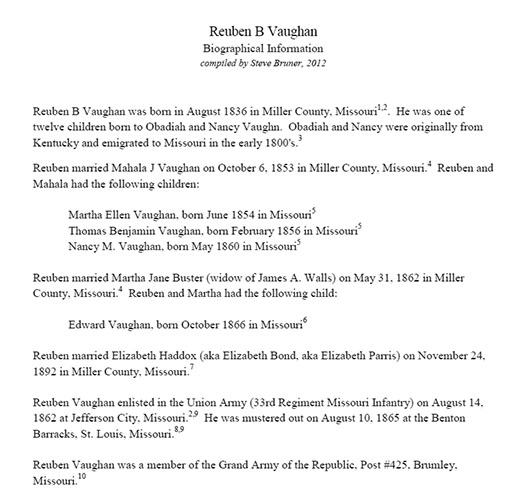
08 Reuben Vaughan Biographical Information
Click image to read entire document in PDF format.
Another of the portraits on our wall in the library of the museum is that of John Robinson Bond. The portrait was donated to us by Jack Atwill of Iberia. Here is a photo I took of the portrait where it is hanging on the wall (photo 09):
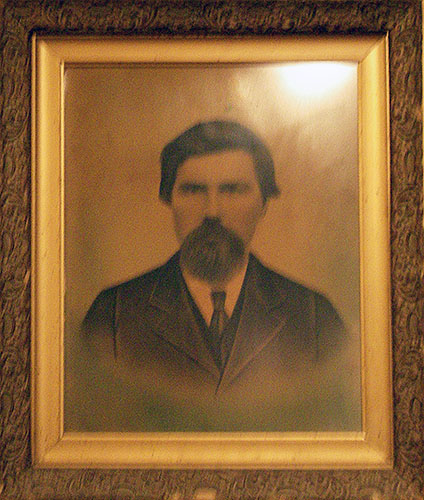
09 John Robinson Bond
And here is another photo of John Robinson Bond I copied from a previous Miller County Museum newsletter (photo 10):
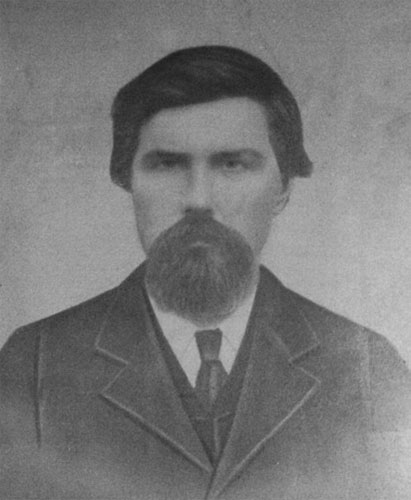
10 John Robinson Bond
Jack supplied us with the following short biography of John Robinson Bond:
John Robinson Bond was born in Miller County December 14, 1843, the son of Felix H. and Elizabeth Burks Bond, early pioneers of Miller County. He died July 21, 1932 in Iberia following a five year period of paralysis of the left side of his body. He married Sarah A. Watkins November 24, 1861 and to this union were born ten children: Edward, Emma, James, Samuel, Doly, Fanny, Alcena, Lou and Bird.
John’s first wife died in 1912 and in October of 1914 he married Mary E. Holloway Wright. About that time he united with the Hickory Point Baptist Church.
John was a successful farmer, Civil War veteran, a Mason and served on the board of directors of the Farmers and Traders Bank. He was buried in Livingston Cemetery north of Iberia.
The last public event of this year at the museum was celebrated last Saturday when we offered our annual chili dinner, the music of the Joe Jeffries country music group, and a classic car show. The weather cooperated which may be one reason that more than one hundred guests attended. Here are some photos of the visitors (photos 11 and 12), classic cars (photos 13 - 31) and Joe Jeffries with his musical group (photos 32, 33 and 34).
Many thanks are due to Larry Flaugher of Eldon who organized our classic car show.
We had more visitors for this event than any other this year, probably because the weather was so pleasant and also because this was the last opportunity of the year for those who hadn’t visited the museum to come and see us.
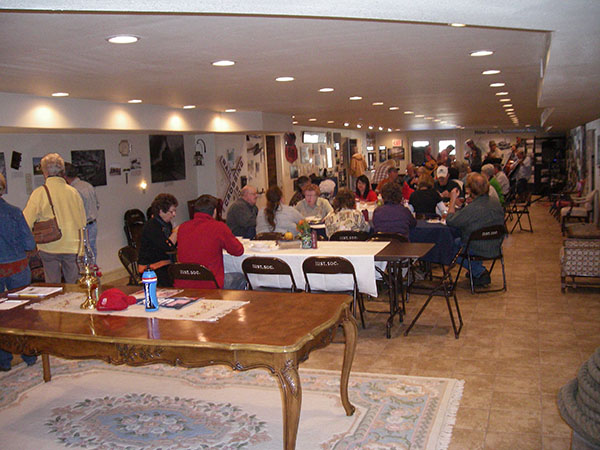
11 Chili Dinner
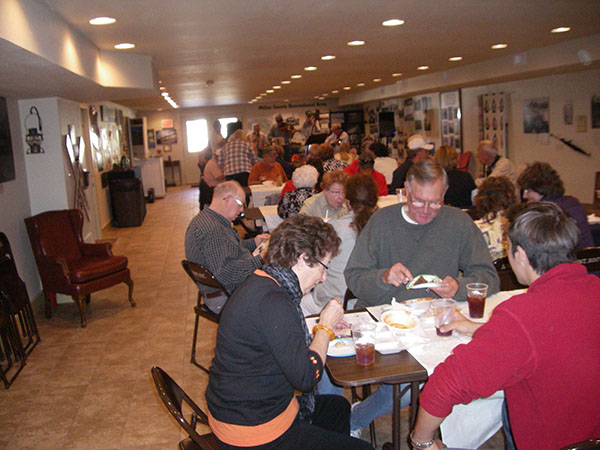
12 Chili Dinner
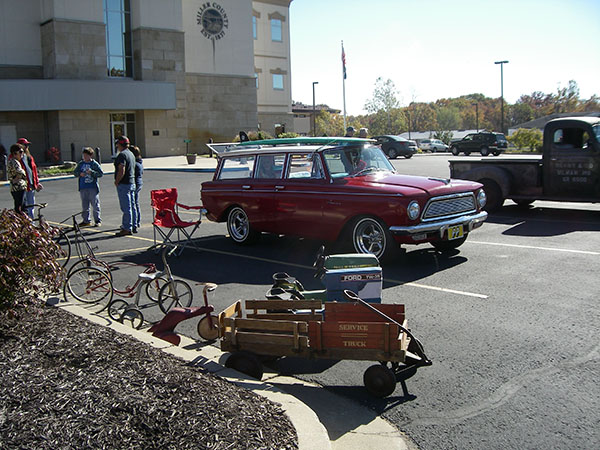
13 Car Show
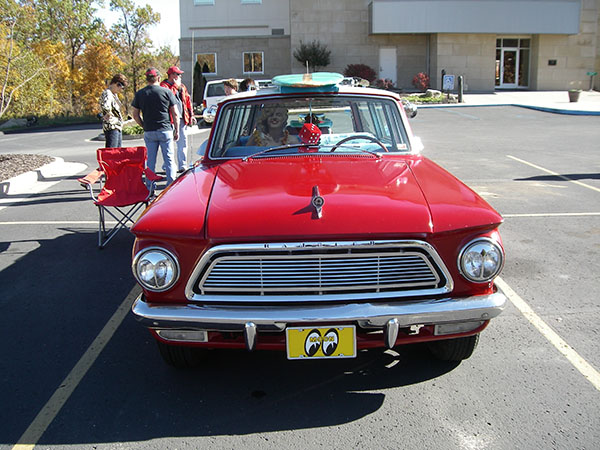
14 Car Show
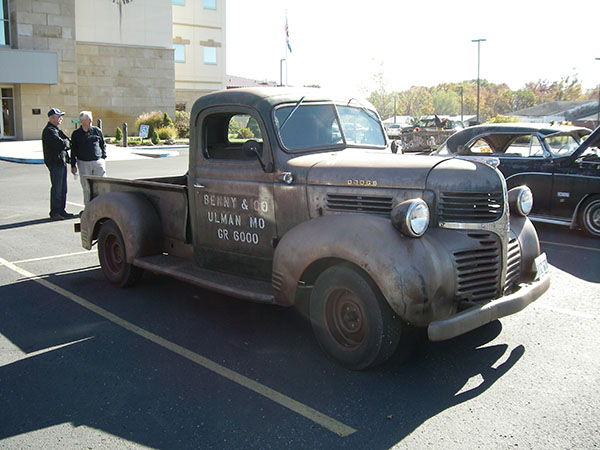
15 Car Show
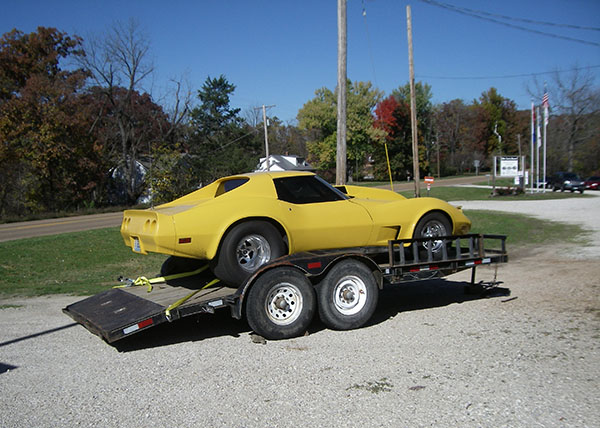
16 Car Show

17 Car Show

18 Car Show
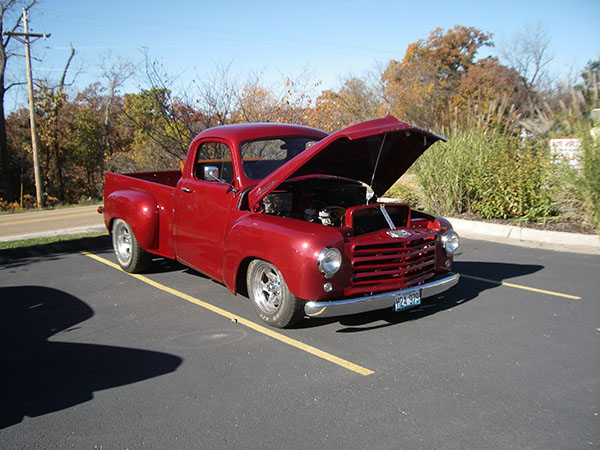
19 Car Show

20 Car Show

21 Car Show
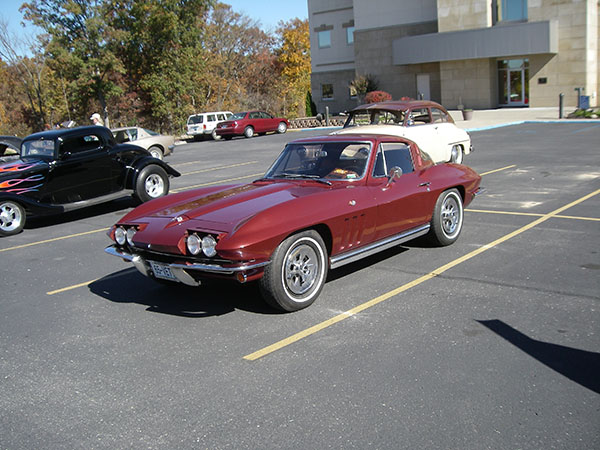
22 Car Show
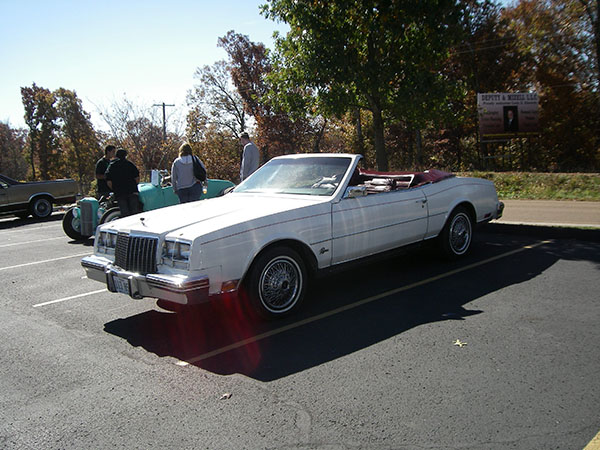
23 Car Show
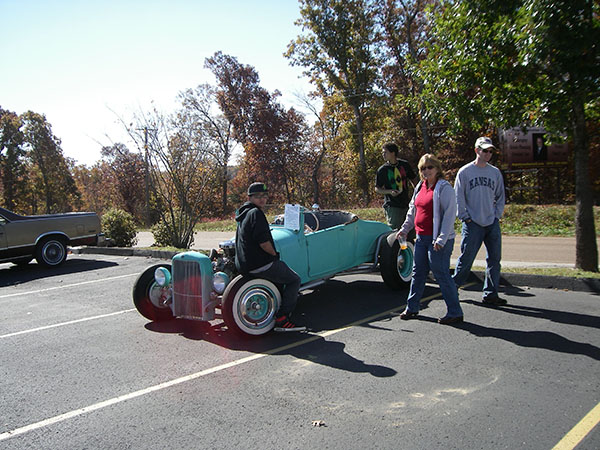
24 Car Show
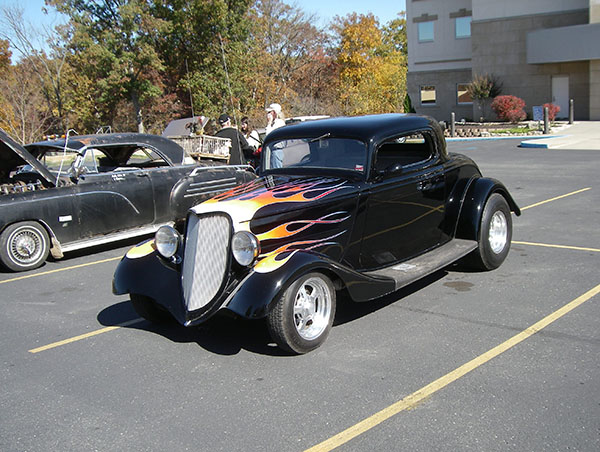
25 Car Show

26 Car Show

27 Car Show

28 Car Show
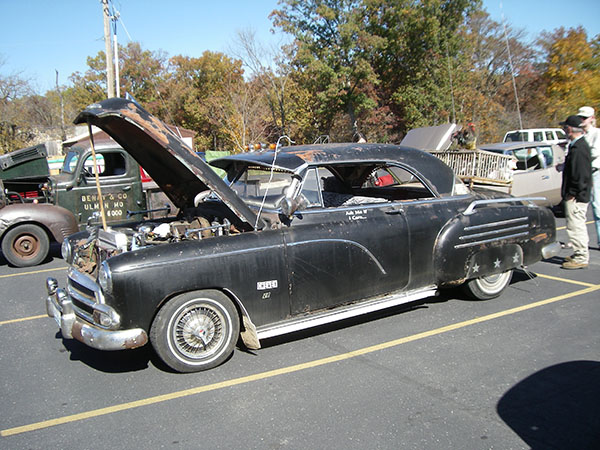
29 Car Show

30 Car Show

31 Car Show
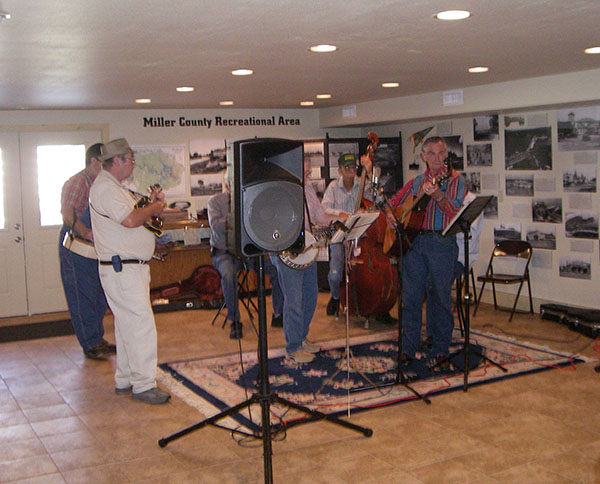
32 Joe Jeffries Group
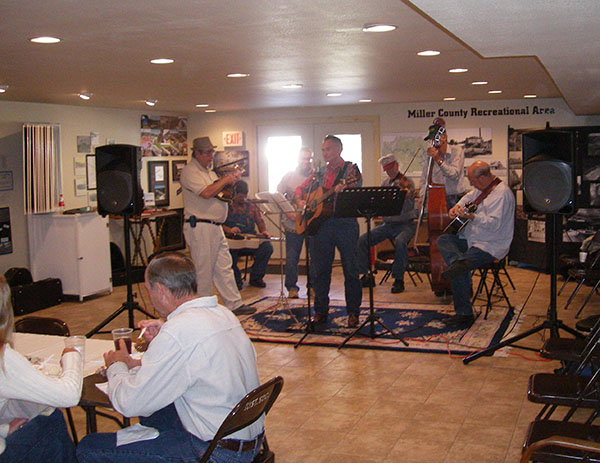
33 Joe Jeffries Group
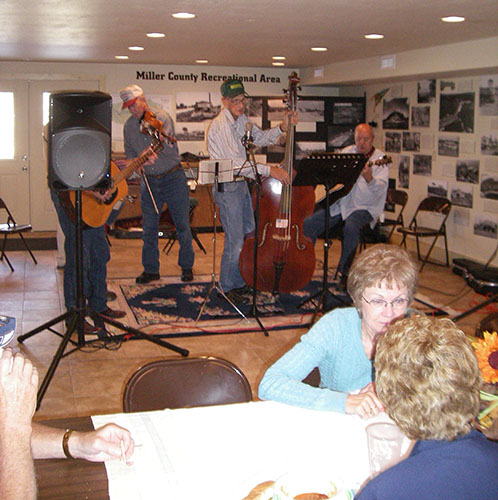
34 Joe Jeffries Group
I am going to take a “sabbatical” over the winter for a number of vacation opportunities with my wife Judy. The traveling will be such that I will not have access regularly to the internet nor the variety of research sources I need for writing Progress Notes.
However, the very well-known and respected Miller County historian, Peggy Hake (photo 35), whom, as regular readers know I have quoted often for my historical articles about Miller County, has agreed to submit her current weekly Windows to the Past article to our website which you can access here.
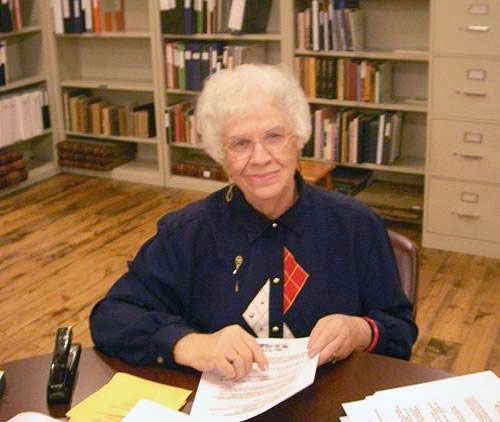
35 Peggy Hake
In addition to this new venue for Peggy, don’t forget that we previously downloaded many if not most of her Windows to the Past biographies at this location on our website.
The Progress Notes I have written previously will remain stored in the archives drop down box at the top of this page. Since I began the series in April of 2007 almost three hundred different narratives and thousands of photos have been uploaded. So for those of you who have not been a regular visitor to this page of our website, now would be a good time to peruse the previous Progress Notes in the archives.
That’s all for this week.
 Joe Pryor
Previous article links are in a dropdown menu at the top of all of the pages.
|

